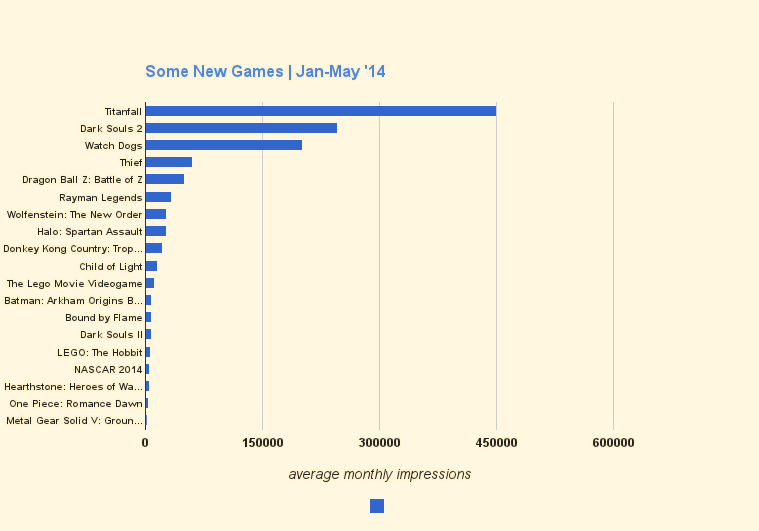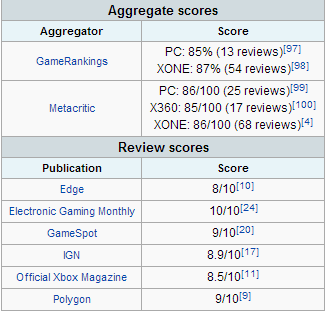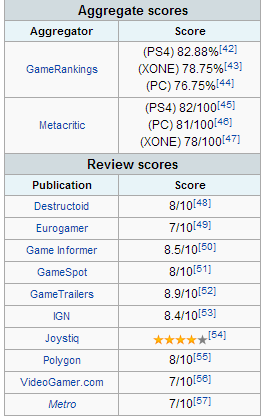This post has not been edited by the GamesBeat staff. Opinions by GamesBeat community writers do not necessarily reflect those of the staff.
Although gaming preferences and popularity fluctuate across genres, cultures, and locations, there are some undeniable truths in majority appeal.
I took 82 games from one of G4’s most popular games list and entered them into Google’s Keyword/AdWords tool. Why 82 and not 100? Well, when I first grabbed this list only 82 were displayed for some reason. Why G4 and not some other top list? It seemed pretty obsolete where the list came from. Mainly, I just wanted a list without League of Legends (more on that later).
The AdWords tool shows both the average number of monthly searches and competitiveness of the exact keywords entered. So, for example, if we want exact search data for “Mincecraft“, something like “2014 Minecraft mods” will not count as an impression. This helps shape a more accurate representation of organic searches, which would otherwise have been skewed by fans looking for mods, cheats, art, comics, etc.
The following graph shows the average number of exact match searches for the most recent 12 month period.
(click to expand)

A few caveats:
As you might expect, this isn’t a ‘perfect’ representation of data. Exact “World of Warcraft” searches might be organic ways to simply see news or related websites. Also, there may be some discrepancy between whether World of Warcraft expansions are “similar enough” to game sequels, such as BioShock Infinite, to warrant combining their previous versions into one. However, this is ideal enough to visualize some trends.
Let’s do a quick breakdown of the top 5 spots
(ams = average monthly searches):
1. Minecraft – 6,120,000 ams
Age: 3 years since full release, 5 years since alpha release
Platforms: PC, Android, iOS, Xbox 360, Xbox One, Raspberry Pi, PlayStation 3, PlayStation 4, PlayStation Vita, Wii U
Total Copies Sold: 35 million+
Does the game have a conclusion? No
Continued Updates?: Yes
2. World of Warcraft – 368,000 ams
Age: 10 years
Platforms: PC
Total Copies Sold: 7 million+ current subscribers (over 100 million accounts created since first release)
Does the game have a conclusion? No
Continued Updates?: Yes
3. The Last of Us – 368,000 ams
Age: 1 year
Platforms: PlayStation 3, PlayStation 4
Total Copies Sold: 6 million+
Does the game have a conclusion? Yes
Continued Updates?: No (possible sequel)
4. Injustice: Gods Among Us – 368,000 ams
Age: 1 year
Platforms: Android, iOS, PC, PlayStation 3, PlayStation 4, PlayStation Vita, Wii U, Xbox 360
Total Copies Sold: 1 million+
Does the game have a conclusion? No
Continued Updates?: No (sequel rumors)
5. BioShock Infinite – 301,000 ams
Age: 1 year
Platforms: PC, PlayStation 3, Xbox 360
Total Copies Sold: 6 million+
Does the game have a conclusion? Yes
Continued Updates?: Yes (2K Games plans to continue expansion)
From this handful we notice a few things, such as launch inflation and the stabilization of searches. Popularity and longevity is demonstrated by Minecraft and WoW, supported by continuous expansions, global reception, and tremendous amounts of user generated content. The Last of Us, Injustice: Gods Among Us, and BioShock Infinite demonstrate a similar pattern of launch inflation tapering off into stabilized search traffic. While BioShock and The Last of Us are acclaimed and sustained by their praised storylines and character development, Injustice: Gods Among Us sustains on referential reception. The difference in sustainability is the difference between:
“A game we have to play at least once, because it’s so breathtaking/groundbreaking/[insert buzzword]” and “A game that’s consistently fun to play, because it’s so addicting, competitive, etc.”.
BioShock and The Last of Us cement their benefits to players as memorable, even though their very nature is temporary. They might have more impact on gamers in discussions and reflections of their favorite games, but their franchise becomes their only vessel for expansion (as opposed to self-sustaining economies and gameplay that encourages “farming/grinding”).
If you’re wondering why certain games were excluded, such as League of Legends or Dota 2, the reason is very simple:

This would essentially warrant a “League vs. Dota” section, resurrecting dead-horse arguments and raising the question, “Why don’t more companies spend millions on international high-stakes competitions, marketing, and advertising?”. This is also where League of Legends, Dota, Smite, and other MOBAs could be analyzed for their super competitive, instant gratification infused, psychological manipulation tactics, along with catalyzing the progress of the global eSports scene. Also, it’s a bit unfair to games that demo at expos without those multi-million marketing budgets. It’s the difference between setting up a trade show booth like these for a couple grand or making lifelike statues of game characters like this:
However, it’s for these reasons and their similarities it seemed better to just omit the LoL/Dota thing…and it also just makes Minecraft a better fitting anomaly.
I deliberately waited about two months to finish this article to provide another graph showing popularity for new releases like Titanfall and Watch Dogs.
For the top 3 we have Titanfall with 450,000 ams, Dark Souls 2 with 250,000 ams, and Watch Dogs with 200,000 ams.
And here’s the monthly search graph for Titanfall:
Regardless of scale, most games follow this traffic pattern: early teasers and trailers followed by marketing build-up, beta hype, and eventually launch. After launch, traffic descends to a point of sustainability or falls into the abyss. In Titanfall’s case, the Jan-April period was incredibly fruitful, having won over 60 awards at E3 2013. The game itself can fairly be summarized as a step forward in multiplayer FPS, although the campaign mode was widely shunned as trivial. Reception was still pretty positive:
One element of the popularity equation is differentiating from awareness. Take Watch Dogs for example. Two years of anticipation with over 90 awards and nominations at E3 2013 greatly inflated expectations. Having just released, the scores are do not match the hype:
In a few months it will be interesting to see how the search traffic weathers an over-hyped game coupled with mixed reception. Many reviewers describe the plot as dissatisfying and brittle, making no real emotional connection with players. Sustainability seems to primarily ride on the intersecting and open player worlds. Many have ridiculed it for bearing too many GTA elements, but some actually enjoy it for this reason.
The business models and goals of developers and publishers also greatly impact the longevity of games. But for the sake of discussion, here are some of the more basic awareness, popularity, and sustainability factors:
Contributing Awareness Factors
- Marketing/Advertising (trailers, demos, contests, active social media presence with “teaser content”, press coverage, events/expos)
- Exclusive alpha/beta
Contributing Popularity Factors
- User Generated Content (mods, videos, reviews)
- Authority Signals (ie; TotalBiscuit highly praises a game)
- Word of Mouth praise
Contributing Sustainability Factors
- Expansive patches / DLC
- Remarkable production: a paramount story / memorable character(s), timeless compositions, and unforgettable voice actors
- User Generated Content (mods, videos, reviews, comics/art, communities/fan sites)
- Public and responsive development team in their communities
- Rankings and Currencies (levels, points, awards, titles, etc.)
What factors do you think contribute to a game’s sustainability? Or what do you think ruins an over-hyped game?









